WASHINGTON ― When Baltimore resident Arjun kisses his 6-year-old daughter’s forehead, it’s not always just a sign of affection.
His daughter, Sujata, is onto him. “Is that a temperature kiss?” she asks.
Arjun compulsively checks his little girl’s temperature for a reason. Sujata is the survivor of the “first well-described case” of extensively drug-resistant tuberculosis in a young child in the U.S., according to her physicians.
Tuberculosis is the world’s biggest killer among infectious diseases, and extensively drug-resistant tuberculosis ― or XDR-TB, which is resistant to the most effective treatment regimens available ― is the most dangerous form of the disease. It has a survival rate of just 30 to 50 percent, and that’s for those who receive treatment.
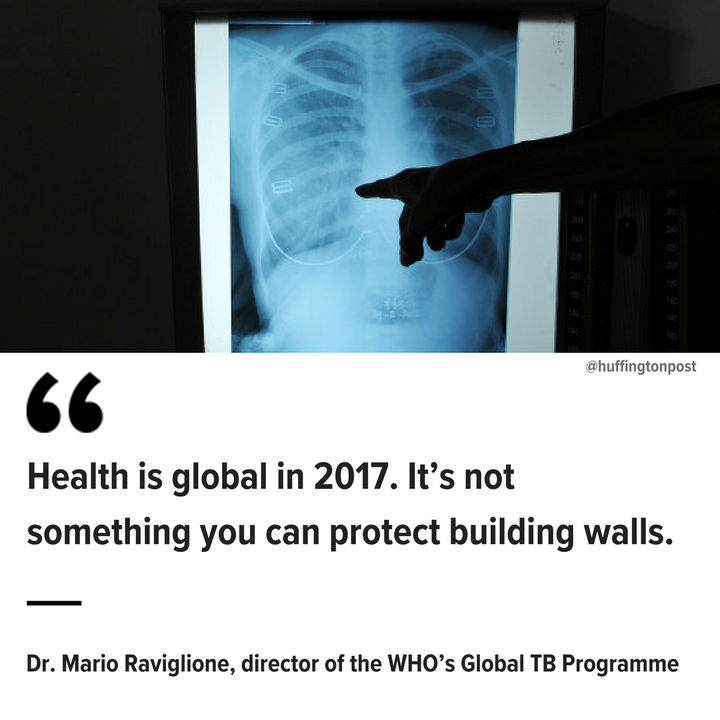
Sujata was declared to be in remission in 2015, but her family still worries the illness might come back. Her family is so nervous about the stigma around the disease that they asked not to be identified by their real names in this report. They haven’t told anyone beyond their closest family and friends about Sujata’s battle.
Sujata contracted XDR-TB at the age of 2, while visiting her grandparents in Mumbai, India, in 2013. It started with a high fever during the last two weeks of the visit. Although multiple doctors in India and Baltimore told Sujata’s family she had an upper respiratory infection, then malaria, then pneumonia, her physician father insisted she had something more serious. It took over a month before she was finally diagnosed with tuberculosis.
The doctors started the typical treatment and she got better, but only briefly. It took another three months, an X-ray with suspicious lesions, and her parents’ insistence that something was still wrong before Sujata was diagnosed with extensively drug-resistant tuberculosis.
Arjun broke down crying upon hearing the news. The chances of surviving this rare form of TB are not great. And his daughter was just a toddler.
Tuberculosis cases like Sujata’s are what worry global public health experts the most. About 5 percent of active TB cases are estimated to be multidrug-resistant, or MDR-TB, which means the bacteria have mutated to not respond to the two strongest TB drugs. Extensively drug-resistant TB, which doesn’t respond to at least four of the most common treatments, makes up about 0.4 percent of TB cases globally. Experts expect the numbers for both these rare forms to rise.
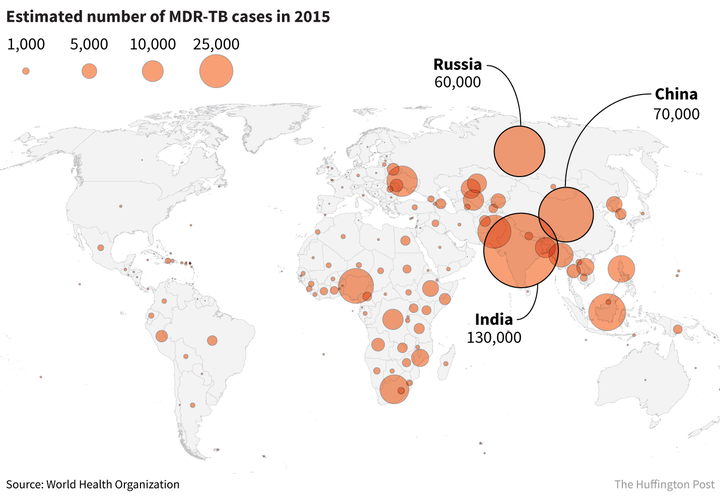
While an estimated 480,000 people contracted MDR-TB in 2015, only a quarter of them actually received treatment, and only about half of those who receive treatment are cured. In contrast, 90 percent of those treated for standard tuberculosis survive.
An estimated 75 million additional people will lose their lives by 2050 as a result of MDR-TB, according to a 2015 United Kingdom government report, and the economic loss from the drug-resistant form of the disease will rise to $16.7 trillion over that period. A report from the Lancet Respiratory Medicine Commission published Thursday stressed that a growing increase in multidrug-resistant TB “threatens to derail decades of progress.”
Understanding TB Today
Tuberculosis returned to the list of the top 10 causes of death globally in 2016. Even though the number of TB deaths fell 22 percent from 2000 to 2015, 1.8 million people a year ― about three people every minute ― still die from TB, an illness that is both treatable and curable.
TB is an airborne disease spread when an infectious person coughs up micro-droplets of saliva and mucus. It can be picked up by anyone, anywhere.
“This is a disease that literally knows no boundaries,” said Dr. Christine Sizemore, chief of the Tuberculosis, Leprosy and Other Mycobacterial Diseases Section at the U.S. National Institute of Allergy and Infectious Diseases.
Read more about the U.S. tuberculosis caseload in 2016.
While the number of cases in the United States is low and continuing to decline ― 9,287 new cases last year ― the number of drug-resistant cases is concerning. In 2015, there were 88 cases of MDR-TB and one case of XDR-TB in the U.S.
The cost of those drug-resistant cases ― in terms of medical treatment, patient care and lost productivity ― was astronomical. It too is only expected to grow.
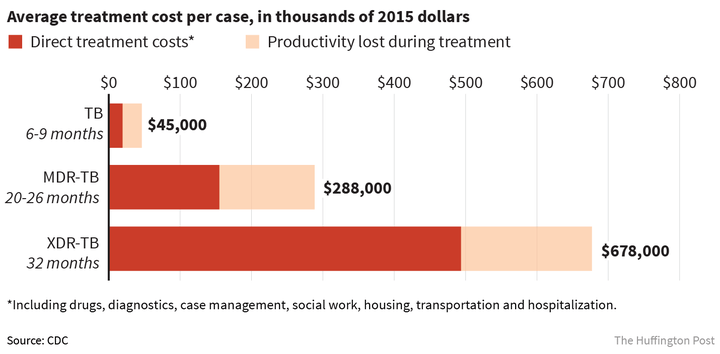
“Health is global in 2017. It’s not something you can protect building walls,” said Dr. Mario Raviglione, director of the World Health Organization’s Global TB Programme.
Over the past year, there have been promising signs of political will to fight a disease that the WHO declared a global health emergency in 1993. Health advocates celebrated a major win when the United Nations announced this past December that it would hold its first high-level meeting focusing solely on TB in 2018.
Political leaders from countries bearing the brunt of the epidemic are also stepping up. India’s Prime Minister Narendra Modi called for an “end TB by 2025” action plan for his country, and Russian President Vladimir Putin is expected to speak at the first-ever Global Ministerial Conference on Ending TB in Moscow this fall.
“If we have this type of momentum, you cannot avoid being hopeful,” Raviglione said. “It’s a matter of political will, commitment and translation into investment and financing.”
The Funding Question
That investment part is key. There is a $2 billion investment gap in the efforts of low- and middle-income countries to fight tuberculosis each year, plus a $1.3 billion shortfall in research and development, according to the WHO’s 2016 Global Tuberculosis Report.
The U.S. is by far the biggest single-government funder of global tuberculosis prevention and treatment efforts. Three federal agencies are chiefly involved: the U.S. Agency for International Development (USAID), which oversees international efforts to combat TB; the National Institutes of Health (NIH), which is the foremost donor in TB research and development; and the Centers for Disease Control and Prevention (CDC), which works on global and national prevention and treatment. The U.S. is also the largest donor to the Global Fund for AIDS, Tuberculosis and Malaria, with a $10.6 billion commitment that is more than double that of the next largest donor.
Some global health experts hope that President Donald Trump will make fighting TB part of his legacy, much as President George W. Bush did with AIDS. But the signals from Trump’s first budget proposal aren’t very promising. While the budget plan released March 16 would maintain the commitment to the Global Fund, it proposed a 28 percent combined cut to the State Department and USAID and an 18 percent cut to the NIH. Trump’s views on funding the CDC were not spelled out in the budget.
“This is about people dying and people infecting others. It’s about the lives saved and how do we ultimately even protect ourselves.”
- Lucica Ditiu, executive director of the Stop TB Partnership
If Congress approves those cuts and they hit the tuberculosis programs, it could be devastating to the fight against TB. However, global health programs have typically received bipartisan support in Congress. For four consecutive years, President Barack Obama proposed cutting funding for tuberculosis by 19 percent. Congress rejected the idea each time.
Still, public health experts worry that drastic cuts can lead to fighting among the health agencies and destructive trade-offs between money for programs that fight TB today and money for research to fight TB better in the future.
“Stifling that [research], and not being able to continue our advances in that area, I think will probably have repercussions in the areas of human health that we may not predict at this point,” said Sizemore, of the NIH.
Lucica Ditiu, executive director of the international Stop TB Partnership, stressed the human cost of the kind of cuts Trump has proposed. “This is about people dying and people infecting others,” Ditiu said. “It’s about the lives saved and how do we ultimately even protect ourselves.”
“Such a cut would certainly set back American leadership and ultimately come back to haunt us in terms of domestic health costs,” warned David Bryden, a tuberculosis advocacy officer for the nonprofit Results.
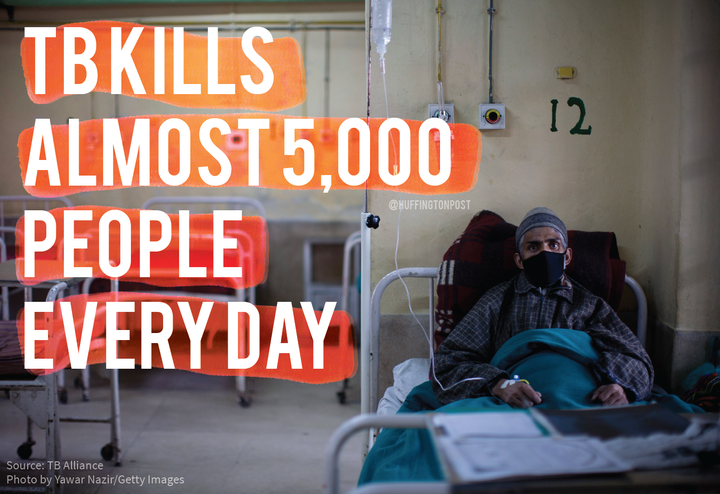
Sujata’s Battle
For Sujata, the fight against tuberculosis is a bit more personal. She went through 20 months of treatment, with rounds of five different medications. One drug had to be administered through a central line in her chest for six months, during which she was quarantined at home.
Arjun worried about the potential side effects of the medications Sujata was taking ― hearing and vision loss, damage to her kidneys. But “it was life and death vs. these side effects,” he said, “so we didn’t have a choice.”
He credits the doctors at Johns Hopkins Children’s Center, where Sujata was primarily treated, and the CDC for her survival. “It literally took a team of experts in their fields to come up with a plan to treat her, and you could not get a team of experts like this anywhere else,” Arjun said.
Sujata and her family lobbied members of Congress to sustain funding for tuberculosis programs on Tuesday in advance of World TB Day. “We need your help in curing everyone who has this infection,” she wrote in a statement she delivered in meetings with two senators, a congressman and congressional staffers on Capitol Hill.
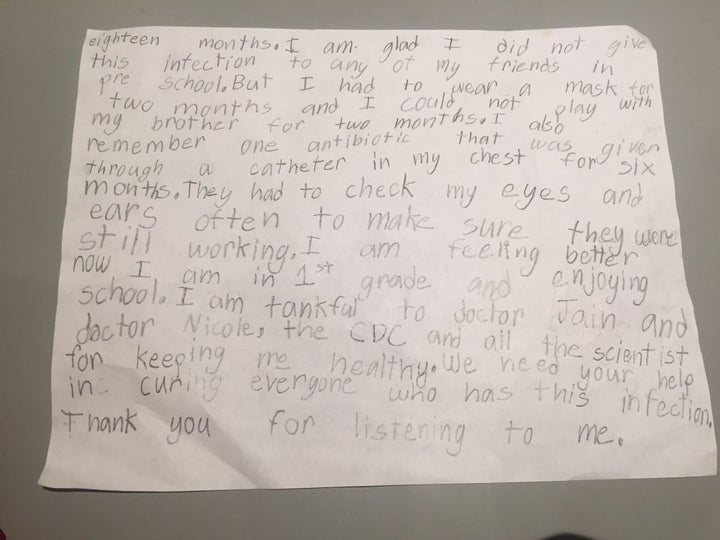
Sujata and her father both stressed the need for more research, particularly into the effective dosage of TB drugs for children with drug-resistant cases, on which there is less data.
Arjun said his daughter’s ordeal just to get the proper diagnosis demonstrates the need to raise awareness about TB in the U.S., where many primary care doctors are unlikely to suspect the disease in their patients.
And yet the herculean effort to save his daughter would not have taken place anywhere else, Arjun believes.
“In any other country, she would not have survived.”
Visuals editor Alissa Scheller contributed to this report.
